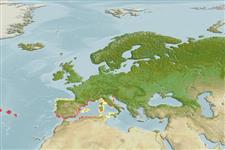>
Gobiesociformes (Clingfishes) >
Gobiesocidae (Clingfishes and singleslits) > Lepadogastrinae
Etymology: Apletodon: Greek, aplatos, apletos = terrible + Greek, odous = teeth (Ref. 45335).
Environment: milieu / climate zone / depth range / distribution range
Ecologia
marino demersale; distribuzione batimetrica 2 - 19 m (Ref. 28715). Subtropical; 45°N - 36°N, 32°W - 14°E
Mediterranean Sea: Rovinj and Premantura (Istria, northern Adriatic Sea), around Elba (Italy), Ibiza (Baleares), Banyuls-sur-Mer (southern France). Northeast Atlantic: Azores.
Size / Peso / Age
Maturity: Lm ? range ? - ? cm
Max length : 2.7 cm SL maschio/sesso non determinato; (Ref. 28715)
Juveniles about 1-2 cm SL are often observed in association with sea urchins and in beds of Posidonia oceanica. Adults found hidden under stones covered with red calcareous algae and empty shells of mussels near Posidonia and Cymodocea nodosa beds. Among Posidonia, the species is often sympatric with Opeatogenys gracilis (Ref. 28715).
Life cycle and mating behavior
Maturità | Riproduzione | Deposizione | Uova | Fecundity | Larve
Hofrichter, R. and R.A. Patzner, 1997. A new species of Apletodon from the Mediterranean Sea and the eastern Atlantic with notes on the differentiation between Apletodon and Diplecogaster species (Pisces: Teleostei: Gobiesociformes: Gobiesocidae). Senckenbergiana biol. 77(1):15-22. (Ref. 28715)
IUCN Red List Status (Ref. 130435)
Threat to humans
Harmless
Human uses
Informazioni ulteriori
Nomi ComuniSinonimiMetabolismoPredatoriEcotossicologiaRiproduzioneMaturitàDeposizioneSpawning aggregationFecundityUovaEgg development
Age/Size
Accrescimento
Length-weight
Length-length
Length-frequencies
Morfometria
Morfologia
Larve
Dinamica popolazioni larvali
Reclutamento
Abbondanza
BRUVS
BibliografiaAcquacolturaProfilo di acquacolturaVarietàGeneticaElectrophoresesEreditarietàMalattieElaborazioneNutrientsMass conversion
CollaboratoriImmaginiStamps, Coins Misc.SuoniCiguateraVelocitàModalità di nuotoArea branchialeOtolithsCervelliVista
Strumenti
Special reports
Download XML
Fonti Internet
Estimates based on models
Preferred temperature (Ref.
123201): 17.6 - 19.2, mean 18.7 °C (based on 109 cells).
Phylogenetic diversity index (Ref.
82804): PD
50 = 0.5156 [Uniqueness, from 0.5 = low to 2.0 = high].
Bayesian length-weight: a=0.00513 (0.00202 - 0.01305), b=3.11 (2.89 - 3.33), in cm total length, based on LWR estimates for this (Sub)family-body shape (Ref.
93245).
Trophic level (Ref.
69278): 3.1 ±0.5 se; based on size and trophs of closest relatives
Resilienza (Ref.
120179): Alto, tempo minimo di raddoppiamento della popolazione meno di 15 mesi (Preliminary K or Fecundity.).
Fishing Vulnerability (Ref.
59153): Low vulnerability (10 of 100).
